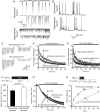Multiple vesicle recycling pathways in central synapses and their impact on neurotransmission
- PMID: 17690145
- PMCID: PMC2375518
- DOI: 10.1113/jphysiol.2007.137745
Multiple vesicle recycling pathways in central synapses and their impact on neurotransmission
Abstract
Short-term synaptic depression during repetitive activity is a common property of most synapses. Multiple mechanisms contribute to this rapid depression in neurotransmission including a decrease in vesicle fusion probability, inactivation of voltage-gated Ca(2+) channels or use-dependent inhibition of release machinery by presynaptic receptors. In addition, synaptic depression can arise from a rapid reduction in the number of vesicles available for release. This reduction can be countered by two sources. One source is replenishment from a set of reserve vesicles. The second source is the reuse of vesicles that have undergone exocytosis and endocytosis. If the synaptic vesicle reuse is fast enough then it can replenish vesicles during a brief burst of action potentials and play a substantial role in regulating the rate of synaptic depression. In the last 5 years, we have examined the impact of synaptic vesicle reuse on neurotransmission using fluorescence imaging of synaptic vesicle trafficking in combination with electrophysiological detection of short-term synaptic plasticity. These studies have revealed that synaptic vesicle reuse shapes the kinetics of short-term synaptic depression in a frequency-dependent manner. In addition, synaptic vesicle recycling helps maintain the level of neurotransmission at steady state. Moreover, our studies showed that synaptic vesicle reuse is a highly plastic process as it varies widely among synapses and can adapt to changes in chronic activity levels.
Figures





Similar articles
-
Synaptic vesicle reuse and its implications.Neuroscientist. 2006 Feb;12(1):57-66. doi: 10.1177/1073858405281852. Neuroscientist. 2006. PMID: 16394193 Review.
-
Two Ca(2+)-dependent steps controlling synaptic vesicle fusion and replenishment at the cerebellar basket cell terminal.Neuron. 2008 Feb 7;57(3):406-19. doi: 10.1016/j.neuron.2007.11.029. Neuron. 2008. PMID: 18255033
-
The efficiency of the synaptic vesicle cycle at central nervous system synapses.Trends Cell Biol. 2006 Aug;16(8):413-20. doi: 10.1016/j.tcb.2006.06.007. Epub 2006 Jul 12. Trends Cell Biol. 2006. PMID: 16839766 Review.
-
High-frequency firing helps replenish the readily releasable pool of synaptic vesicles.Nature. 1998 Jul 23;394(6691):384-8. doi: 10.1038/28645. Nature. 1998. PMID: 9690475
-
The pool of fast releasing vesicles is augmented by myosin light chain kinase inhibition at the calyx of Held synapse.J Neurophysiol. 2008 Apr;99(4):1810-24. doi: 10.1152/jn.00949.2007. Epub 2008 Feb 6. J Neurophysiol. 2008. PMID: 18256166
Cited by
-
Synaptic Vesicle-Recycling Machinery Components as Potential Therapeutic Targets.Pharmacol Rev. 2017 Apr;69(2):141-160. doi: 10.1124/pr.116.013342. Pharmacol Rev. 2017. PMID: 28265000 Free PMC article. Review.
-
History-dependent excitability as a single-cell substrate of transient memory for information discrimination.PLoS One. 2010 Dec 28;5(12):e15023. doi: 10.1371/journal.pone.0015023. PLoS One. 2010. PMID: 21203387 Free PMC article.
-
The Rho-linked mental retardation protein OPHN1 controls synaptic vesicle endocytosis via endophilin A1.Curr Biol. 2009 Jul 14;19(13):1133-9. doi: 10.1016/j.cub.2009.05.022. Epub 2009 May 28. Curr Biol. 2009. PMID: 19481455 Free PMC article.
-
Botulinum Neurotoxins Can Enter Cultured Neurons Independent of Synaptic Vesicle Recycling.PLoS One. 2015 Jul 24;10(7):e0133737. doi: 10.1371/journal.pone.0133737. eCollection 2015. PLoS One. 2015. PMID: 26207366 Free PMC article.
-
Recovery of vesicular storage and release parameters after high frequency stimulation in rat hippocampus.Cogn Neurodyn. 2013 Aug;7(4):311-23. doi: 10.1007/s11571-012-9240-y. Epub 2013 Jan 5. Cogn Neurodyn. 2013. PMID: 24427207 Free PMC article.
References
Publication types
MeSH terms
LinkOut - more resources
Full Text Sources
Miscellaneous

